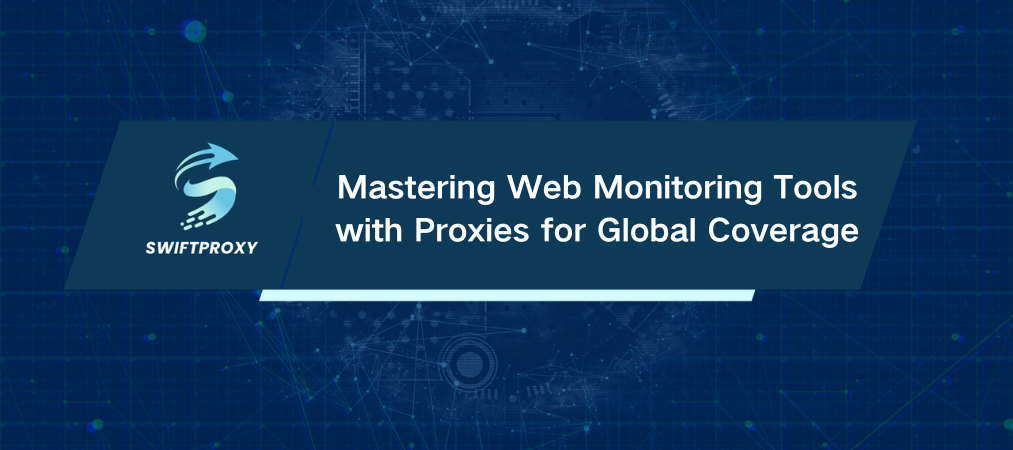Mastering Web Monitoring Tools with Proxies for Global Coverage

Imagine that a website going down costs companies thousands — sometimes millions — every single minute. That's not just downtime. It's lost customers, damaged reputations, and missed opportunities. Staying ahead of these issues means monitoring your web presence constantly, from all corners of the globe. However, not all monitoring is created equal.
That's where proxies come in. They're the secret weapon that lets you peek behind the curtain—checking how your site or app behaves in different regions, bypassing restrictions, and revealing problems no standard tool can spot. No fluff. Just solid, actionable data that keeps you one step ahead.
We're going to show you exactly how to leverage proxies with web monitoring tools. You'll learn what works, what to avoid, and how to set things up for maximum impact. Ready to get your web monitoring game on point? Let's dive in.
Understanding Web Monitoring Tools
Simply put, web monitoring tools keep an eye on your website or app 24/7. They check if your site is live, how fast it responds, and whether users in different locations can access it without hiccups.
These tools don't just ping your site every now and then. They gather detailed reports, detect errors, and send alerts when something breaks. That means you can fix problems before your users even notice.
Here's what to look for in your monitoring toolkit:
Uptime Monitoring: Measures how often your site is reachable and stable over time.
Performance Analysis: Checks load times and suggests ways to speed things up.
Error Detection: Finds bugs, security flaws, and configuration issues.
Key Web Monitoring Tools You Should Know
Uptime Monitoring:
UptimeRobot: Checks your site every 5 minutes and sends alerts via email or Telegram.
Pingdom: Offers detailed reports and tests from multiple global locations.
StatusCake: Runs frequent checks with real-time reports worldwide.
Performance Analysis:
Google PageSpeed Insights: Breaks down site speed and optimization tips.
GTmetrix: Delivers deep dive reports on load times and bottlenecks.
WebPageTest: Tests from various browsers and countries, showing step-by-step load sequences.
Error and Vulnerability Detection:
Sentry: Tracks application bugs live and gives detailed error diagnostics.
Detectify: Scans for security weaknesses automatically.
Site24x7: Combines uptime, performance, and vulnerability checks on one platform.
Why Proxies Are a Game-Changer in Web Monitoring
If your goal is accurate, reliable monitoring, proxies are non-negotiable. Why? Because websites and apps often block or filter traffic based on IP addresses. Without proxies, your monitoring tools might hit a wall—literally.
Proxies let you:
Bypass regional restrictions — test your site exactly as users in different countries see it.
Simulate real user behavior — uncover geo-specific problems and content delivery issues.
Stay anonymous and secure — avoid triggering security alerts that can block your monitoring efforts.
Picking the Right Proxy for Your Needs
Not all proxies are the same. Choosing the right type depends on your project's goals and budget. Here's a quick rundown:
Residential Proxies: Real IPs from actual devices. Hard to detect, ideal for stealthy, geo-specific tests. Pay per GB, so use wisely.
Data Center Proxies: Fast, static IPs from data centers. Cost-effective for basic checks but easier to block.
Mobile Proxies: IPs assigned by mobile carriers. Best for simulating real mobile users, high security, but slower and pricier.
ISP Proxies: Static IPs from internet service providers, combining speed and trustworthiness.
Test different proxies to find the perfect balance of speed, accuracy, and stealth.
How to Set Up Proxies for Web Monitoring Tools
Getting proxies to work with your monitoring software doesn't have to be complicated. Here are popular setup options:
Windows: Configure proxies in network settings for quick use, though limited control.
macOS: Setup via Wi-Fi preferences, good for simple cases but lacks multi-IP management.
Proxifier: Powerful proxy management software allowing IP rotation, filtering, and automation — ideal for complex, multi-threaded monitoring.
Choose a setup that fits your scale. For broad geo-targeted checks, proxy management apps are your best bet.
Keep Your Proxies Healthy and Effective
Setup is just the start. Monitor your proxies regularly for:
IP availability and uptime
Accurate geo-location
Routing integrity
Response times and latency
Use proxy health tools to catch issues before they affect your monitoring. That way, you ensure your data stays reliable and actionable.
Conclusion
Web monitoring tools keep your digital presence sharp and responsive. Pair them with the right proxies, and you break down barriers — testing from anywhere, protecting your identity, and uncovering hidden issues.
The difference between good monitoring and great monitoring? It's all in the details. Choose your proxies carefully, configure your tools smartly, and you'll catch problems faster than anyone else.
關於作者

Imagine that a website going down costs companies thousands — sometimes millions — every single minute. That's not just downtime. It's lost customers, damaged reputations, and missed opportunities. Staying ahead of these issues means monitoring your web presence constantly, from all corners of the globe. However, not all monitoring is created equal.
That's where proxies come in. They're the secret weapon that lets you peek behind the curtain—checking how your site or app behaves in different regions, bypassing restrictions, and revealing problems no standard tool can spot. No fluff. Just solid, actionable data that keeps you one step ahead.
We're going to show you exactly how to leverage proxies with web monitoring tools. You'll learn what works, what to avoid, and how to set things up for maximum impact. Ready to get your web monitoring game on point? Let's dive in.
Understanding Web Monitoring Tools
Simply put, web monitoring tools keep an eye on your website or app 24/7. They check if your site is live, how fast it responds, and whether users in different locations can access it without hiccups.
These tools don't just ping your site every now and then. They gather detailed reports, detect errors, and send alerts when something breaks. That means you can fix problems before your users even notice.
Here's what to look for in your monitoring toolkit:
Uptime Monitoring: Measures how often your site is reachable and stable over time.
Performance Analysis: Checks load times and suggests ways to speed things up.
Error Detection: Finds bugs, security flaws, and configuration issues.
Key Web Monitoring Tools You Should Know
Uptime Monitoring:
UptimeRobot: Checks your site every 5 minutes and sends alerts via email or Telegram.
Pingdom: Offers detailed reports and tests from multiple global locations.
StatusCake: Runs frequent checks with real-time reports worldwide.
Performance Analysis:
Google PageSpeed Insights: Breaks down site speed and optimization tips.
GTmetrix: Delivers deep dive reports on load times and bottlenecks.
WebPageTest: Tests from various browsers and countries, showing step-by-step load sequences.
Error and Vulnerability Detection:
Sentry: Tracks application bugs live and gives detailed error diagnostics.
Detectify: Scans for security weaknesses automatically.
Site24x7: Combines uptime, performance, and vulnerability checks on one platform.
Why Proxies Are a Game-Changer in Web Monitoring
If your goal is accurate, reliable monitoring, proxies are non-negotiable. Why? Because websites and apps often block or filter traffic based on IP addresses. Without proxies, your monitoring tools might hit a wall—literally.
Proxies let you:
Bypass regional restrictions — test your site exactly as users in different countries see it.
Simulate real user behavior — uncover geo-specific problems and content delivery issues.
Stay anonymous and secure — avoid triggering security alerts that can block your monitoring efforts.
Picking the Right Proxy for Your Needs
Not all proxies are the same. Choosing the right type depends on your project's goals and budget. Here's a quick rundown:
Residential Proxies: Real IPs from actual devices. Hard to detect, ideal for stealthy, geo-specific tests. Pay per GB, so use wisely.
Data Center Proxies: Fast, static IPs from data centers. Cost-effective for basic checks but easier to block.
Mobile Proxies: IPs assigned by mobile carriers. Best for simulating real mobile users, high security, but slower and pricier.
ISP Proxies: Static IPs from internet service providers, combining speed and trustworthiness.
Test different proxies to find the perfect balance of speed, accuracy, and stealth.
How to Set Up Proxies for Web Monitoring Tools
Getting proxies to work with your monitoring software doesn't have to be complicated. Here are popular setup options:
Windows: Configure proxies in network settings for quick use, though limited control.
macOS: Setup via Wi-Fi preferences, good for simple cases but lacks multi-IP management.
Proxifier: Powerful proxy management software allowing IP rotation, filtering, and automation — ideal for complex, multi-threaded monitoring.
Choose a setup that fits your scale. For broad geo-targeted checks, proxy management apps are your best bet.
Keep Your Proxies Healthy and Effective
Setup is just the start. Monitor your proxies regularly for:
IP availability and uptime
Accurate geo-location
Routing integrity
Response times and latency
Use proxy health tools to catch issues before they affect your monitoring. That way, you ensure your data stays reliable and actionable.
Conclusion
Web monitoring tools keep your digital presence sharp and responsive. Pair them with the right proxies, and you break down barriers — testing from anywhere, protecting your identity, and uncovering hidden issues.
The difference between good monitoring and great monitoring? It's all in the details. Choose your proxies carefully, configure your tools smartly, and you'll catch problems faster than anyone else.


















































